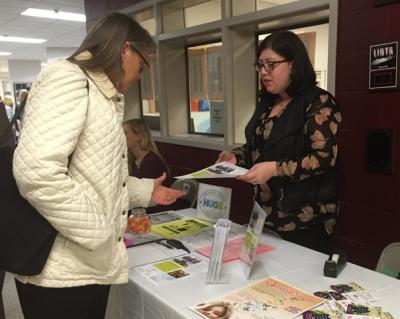Drug Expert: ‘I’ve Never Seen It Like This’

When Steve Chassman asked who in the audience knew someone who was addicted to drugs or alcohol, a wave of sobering reality seemed to wash over the crowd of more than 150 people who were gathered at East Hampton High School for a community forum on the prevention of drug abuse.
Almost everyone’s hand went up.
“All of us, collectively, are in the midst of a health epidemic at a rate we’ve never before seen,” said Mr. Chassman, the executive director of LICADD, the Long Island Council on Alcoholism and Drug Dependence. “If you hear a sense of urgency in my voice, I’ve been a social worker for 23 years, and I’ve never seen it like this.”
High school officials convened the March 23 forum after noticing an uptick this year in drug-related incidents. According to Mr. Chassman’s organization, East Hampton is hardly the only community facing issues of addiction.
In Nassau County, according to LICADD, deaths from drug overdose increased from 24 in 2004 to 58 in 2015. In Suffolk County over the same time period, overdose fatalities shot up from 32 to 103. This February alone, about 1,400 Long Islanders came to LICADD for assistance.
“The world has changed, and so have the drugs. If you want insight into the human condition, it’s not what folks use. It’s why,” Mr. Chassman said, outlining a long list of reasons including peer pressure, anxiety, relaxation, curiosity, social acceptance, depression, escapism, and genetic predisposition. Addiction, he said, affects young people disproportionately because of many of those factors, with children as young as 11 trying “gateway” drugs — alcohol, marijuana, nicotine — and moving on to more dangerous substances by the age of 15 or 16.
“This is a tumultuous time in adolescence,” Mr. Chassman said. “At the height of the digital and technological revolution, we have to teach healthy coping skills to offset the world moving at a pace that has increased exponentially, when our young people have turned to substance abuse more than ever.”
Those skills, he said, might include such pursuits as exercise, athletics, and self-expression, through art, music, journaling, or other creative outlets.
Stephanie Sloan, a senior drug abuse educator with the Suffolk County Division of Community Mental Hygiene, broke down numerous warning signs that might alert parents if their child is using drugs. They include changes in weight, mood swings, letting go of personal grooming habits, unusual smells, nosebleeds, slurred or incoherent speech, changes in relationships, seizures with no previous history of having them, loss of interest in hobbies, loss of motivation, paranoia and anxiety, decreasing academic performance, discipline issues at school, and becoming silent or withdrawn.
“Some of these are going to be normal in adolescents, but they’re going to happen very quickly or you’re going to notice quite a few of them happening at the same time,” Ms. Sloan said. “Trust your gut. If you have a gut feeling that something is going on, something is going on.”
She also urged parents to make sure they have their children’s passwords to their computers, social media accounts, and cellphones. “They have no right to privacy. Ask for their passwords,” Ms. Sloan said. “If they don’t want to give it to you, there’s a reason. It’s important, because at the end of the day, it could end up saving their life.”
At the forum, nearly every adult over the age of 18 received training in the use of naloxone, often called Narcan, a drug that reverses or blocks the effects of an opioid overdose. Those who registered with the county were able to take home a naloxone kit in case of emergency.
The forum brought together not just LICADD and Suffolk County Emergency Medical Services, but also the Family Service League, Human Understanding and Growth Services, the East Hampton Town Human Services Department, Phoenix House, Narcotics Anonymous, the Seafield Center, and Families in Support of Treatment to offer resources and information.
Operation Big Red Med Disposal was also represented. Tom McAbee, who created the Big Red Med disposal box for unwanted medications, said the campaign has collected more than a ton of discarded medications on the East End. The box can be found at local pharmacies including, he said, White’s Apothecary in East Hampton, the Sag Harbor Pharmacy, and the Shelter Island Pharmacy.
“Our mission is twofold. It is to keep prescriptions out of our water and prevent prescription drug abuse,” Mr. McAbee, a retired banker whose wife is a physician at Southampton Hospital, said. “The more we can promote responsibly disposing of medications, the more benefit the community is going to have. Most people don’t know.”
Few people at the forum were willing to speak afterward about its impact, but at least one parent said its message was extremely important.
“You could really ask questions about what we as parents are doing wrong,” Roslen Tavera, a mother of two, said. Particularly notable, she said, was the message that children aren’t as much entitled to privacy as parents may think when it comes to passwords. “It’s good to know we can demand more from them. It’s our house, our rules,” Ms. Tavera said.
